ABSTRACT
The extracts of Oxalis barrelieri and Cymbopogon citratus were tested for their antifungal activity against Bipolaris oryzae and Fusarium moniliforme, and use as seed treatment coupled with NaCl treatment to improve the seed germination and the seedlings vigor of treated rice seeds. The significance of the inhibitory activity of the plant extracts against B. oryzae and F moniliforme was type of extract and concentration dependent. The ethanolic extract of C. citratus at 10000 ppm, showed the highest inhibitory effect, with 58.51 and 55.9% growth inhibition of F. moniliforme and B. oryzae, respectively. The rice seeds sorted in 20% NaCl solution had a greater mass (quantify), a germination percentage of 12.5% higher as compared to seeds sorted in with water and 19.5% higher than that of unsorted seeds. A moderate positive and significant linear relationship (Rho (78) = 0.427 **, p <0.01) was shown between weight and germination of rice seeds. The ethanol extracts of O. barrelieri and C. citratus stimulated rice seed germination at comparable degree; 15.15 to 22.06% from the top of paper method and 11.1 to 16.2% from sand method in green house trials. Rice seed treatments at 1% concentration exhibited the best germination and reduced the infestation of B. oryzae and F. moniliforme by 25.25 and 9.83%, respectively. Stressed seeds treated with plant extracts showed less pronounced decrease (5.08 %) in germination compared to untreated stressed seed (25.5%). Sorting of rice seeds with 20% NaCl and/or treatment with ethanol extracts of O. barrelieri and C. citratus showed potential green alternative to reduce seed-borne infestation, improvement of rice vigor and seed germination.
Key words: Rice seeds, NaCl sorting, Cymbopogon citratus, Oxalis barrelieri, Infestation, Bipolaris oryzae, Fusarium moniliforme, germination, vigor.
Rice is one of the oldest food crops and constitutes the staple food of more than 60% of people living in the world (Chandrasekaran et al., 2010). Many diseases, including cryptogamic diseases, cause considerable damage in all areas of rice production (Oerke, 2006). Most of these diseases are mainly seed-borne. Bipolaris oryzae andFusarium moniliforme, responsible for the brown spot disease and the bakanae disease in rice, respectively, are mainly found in rice seeds (Mew and Gonzales, 2002). Losses due to these pathogens range from 4 to 52% for B. oryzae (Barnwal et al., 2013) and 4 to 20% for F. moniliforme (Reddy and Sathyanarayana, 2001). Seed dressing of rice to overcome these pathogens has many advantages, including the protection of seed and seedlings against pathogens in the early stages of germination and development. It requires less chemicals application than plants treatment in the field.
It is ecofriendly with minor effects as environmental pollutant and on beneficial to soil organisms, specific to the target pathogens (Sharma et al., 2015). On the other hand, pretreatment of seed is considered as a viable technology to improve rapid and uniform emergence, high vigor and better yields in some crops (Hu et al., 2005). Worldwide and particularly in Cameroon, the majority of rice growers keep seeds from season to season. Most often there is no seed treatment prior to seeding because of lack of knowledge of available chemicals. In addition, some fungicides used for seed treatment are increasingly criticized for their adverse effects (Wilson and Tisdell, 2001); thus, in recent years, there have been considerable pressures on agriculture in reducing their use, and finding better alternatives (Tripathi and Dubey, 2004).
The flora is recognized as the most effective producer of the various biologically active compounds and, some higher plant products have been formulated as botanical pesticides and are used on a large scale as eco-friendly measures in the management of agricultural pests (Dubey et al., 2011). Rice seeds treatment with sodium chloride (NaCl) solutions is an empirical practice. However there has been no investigation on the targets and optimal sorting concentrations, beneficial to the seed health and germination percentage. This work was initiated to study the activity of extracts of Oxalis barrelieri and Cymbopogon citratus, on two rice seed-borne fungi (B. oryzae and F. moniliforme), and to assess their effects on the fungal incidence, the germination percent and seedlings vigor of rice seeds sorted in NaCl solutions.
Rice varieties used
Seeds of red rice from Tonga with rainfed system and Tox 3145-38-2-3 from Ndop with irrigated system; two highly cultivated rice varieties in these localities of the western regions of Cameroon, were used.
Plant material and preparation of plant extracts
C. citratus stapf and O. barrelieri L., whole plants were harvested in Yaoundé-Cameroon; They were identified, respectively, in comparison with the specimen of Herbarium Collection No. 18622 SRF / Cam (YA) of the sample of C. citratus (De Candolle) Staff of the Collector Daniel Dang No. 202 and the specimen of Herbarium Collection No 19798 SRF / Cam (YA) of the sample of O. barreleri Linn of the Collector A.J.M Leeuwemberg No 6048. After harvest, the plant material was dried under shade for one and half month and crushed into fine powder. For aqueous extract, the powder was degreased by dipping 100 g in 600 mL of hexane for 2 h. The mixture was filtered with a fine cloth; the residue obtained was recovered and dried under the hood until the hexane was completely evaporated and further macerated in 600 mL of distilled water for 12 h and filtered through a fine cloth. The resulting filtrate was centrifuged at 6000 g for 20 min and freeze dried to give a powder (AE). For ethanolic extraction, the procedure was roughly the same as for aqueous extraction, except that the residue was macerated in 70% ethanol and the mixture filtered through Whatman paper, and centrifuged. The filtrate obtained was lyophilized (EE).
Synthetic fungicide used
The synthetic fungicide Banko Plus®, made up of 550 g/L chlorotalonil and 100 g/L of carbendanzime was use a positive control.
Evaluation of the in vitro antifungal activities of C. citratus and O. barrelieri extracts
Strains of B. oryzae and F. moniliforme had been identified and, isolated from infected rice seeds by standard mycological techniques (Mathur and Kongsdal, 2003) at the Plant Pathology Laboratory of the Institute of Agricultural Research for Development, Nkolbisson, Cameroon. The antifungal activities of the extracts (aqueous and ethanolic) of C citratus and O. barrelieri were evaluated according to the method described by Grover and Moore (1962) with some modifications. The powders of extracts were dissolved in distilled water and then supplemented at concentrations of 1000, 5000 and 10000 ppm in conical flask containing the Potato Dextrose Agar (PDA) culture media; 5 mg of chloramphenicol was added per liter of culture medium; the whole was autoclaved and poured between 40 to 50°C in the petri dishes.
After solidification of the culture medium, 5 mm diameter mycelial disk was removed in the peripheral zones of an aging culture of 6 (B. oryzae) and 10 (F. moniliforme) days and placed in the center of the petri dish. The dishes thus seeded, were sealed with parafilm and incubated in inverted position at -28°C under a photoperiod of 12 h light aimed at 7 days for B. oryzae and 12 days for F. moniliforme. Two experiments of three replicates were performed. The mycelial growth diameters were measured and percentage inhibitions (I%) was calculated according to the formula:
With DC, the mycelial mean diameter growth in the control non-supplemented dish and DT, the mycelial mean diameter growth in the supplemented petri dish (treatment).
Treatments of rice seeds
Treatment of rice seeds with NaCl
NaCl solutions (300 mL) were prepared at various concentrations: 0 (distilled water), 10, 20 and 30%. Sixty (60) g of rice seed was first introduced into a beaker containing only distilled water (NaCl 0%), and then stirred with a glass rod for about 1 min and allowed to stand until stabilization of the water movement. The floating seeds (S) were recovered by decantation, washed with distilled water and dried (Ts0% S). A portion of the immersed seeds or pellet (C) was recovered, rinsed with distilled water and dried (Ts0% C). The remainder of the pellet was introduced into the 10% NaCl solution and stirred for 1 min; after stabilization of the solution, the supernatant was recovered, rinsed and dried (Ts10% S); a small part of the new pellet was retained, rinsed and dried (Ts10% C). The remainder of the new pellet was introduced into 20% NaCl solution and the cycle was repeated (Ts20% S and Ts20% C) up to the concentration of 30% NaCl (Ts30% S and Ts30% C). Hundred (100) seeds (x 4) of each of the dried lots (Ts0% S, Ts0% C, Ts10% S, Ts10% C, Ts20% S, Ts20% C, Ts30% S and Ts30% C), non-treated seeds (Sec) and total seed soaked in distilled water for 1 min (TM0%), were weighed and the mass expressed in grams. The germination of seeds was also evaluated.
Treatment of rice seeds with plant extracts and synthetic fungicide
The seeds of red rice from Tonga were used due to their low germination potential. The immersed seeds sorted by treatment in the 20% NaCl solution were divided into 5 identical sub samples; 4 sub samples were dipped for 24 h in solutions of ethanol extracts of C. citratus/O. Barrelieri, at respective concentrations of 0, 1, 2 and 4%. One (1) sub sample was soaked in 0.2% of the Banko Plus fungicide used as positive control. Simultaneously, the floating seeds from the 20% NaCl sorting were immersed in distilled water (Sur). Dry seeds (Sec) as used by the farmers served as negative control. After these treatments, seed sub samples (T+0, T+1, T+2, T+ 4%, Banko plus, Sec and T+ Sur) were recovered, dried for 1 h and their germination evaluated.
Germination test
The top of paper method (Rao et al., 2006) was used to evaluate the effect of treatments on rice seeds’ germination. The above sub samples were divided in four replicates of 50 seeds each. Three moistened blotter papers were placed in 90 mm diameter petri dishes and 25 seeds were seeded per dish and incubated at room temperature (-28°C) under a photoperiod of 12 h of light for 7 days, after which the percent germination was evaluated by, counting the number of normal and abnormal seedlings and dead seeds.
Evaluation of the effect of extracts on, the vigor and the seed health of rice seeds
The accelerated aging test (stress) as described by Delouche and Baskin (1973) was used to evaluate the vigor of the seeds. Dried seeds samples from each of the various treatments described above were deposited on the wire mesh supports. The mesh supports were subsequently placed in transparent plastic boxes containing 500 mL of distilled water, so as to avoid contact between the seeds and the water. The boxes were hermetically sealed and placed in the oven at a temperature maintained at 44°C for 72 h (Suraj and Thawatchai, 2010). After this stress, seed samples were removed and subjected to the standard germination test. For the evaluation of the seed health status, seed samples were seeded into the petri dishes containing PDA medium supplemented with 5 g/L of chloramphenicol. Four replicates of 25 seeds each were made, under a photoperiod of 12 h light for 5 days. The infestation incidence of B. oryzae and F. moniliforme were recorded by counting the number seeds colonized by each of the pathogens and the result expressed as percent infection (I%).
Emergence test
Pots of about 1 L were filled up to 4/5 with a mixture of black soil and sand, in the ratio 4:1. The seed samples from the treatments described in ‘treatment of rice seeds with plant extracts and synthetic fungicide’ (T+0%, T+1%, T+2%, T+ 4%, Banko plus, Dry (Sec) and T+ Sur) were sown in pots at 2 cm deep. Each pot contained 15 seeds chosen randomly and, four replicates were made form each treatment. Watering with 20 mL/pot/day was regularly done using tap water. After 12 days of growth, normal seedlings were counted and results expressed in term of percent emergence.
Statistical analysis
The IBM SPSS 23.0 software was used. In order to carry out the parametric tests, the data were transformed whenever necessary, to determine whether there was any significant difference among the average scores of the levels of the independent variables. One, two and three factor ANOVA were applied, values of P < 0.05 were considered as significantly different. The nature of the differences between the means of scores was determined by the Student-Newman-Keuls (S-N-K) multiple comparison test, when the hypothesis of equality of variances was assumed, or by the method of Games-Howell, when this assumption was violated (Morgan et al., 2011). The correlation coefficient of Pearson or Spearman rho, calculated with 99% confidence interval, was used to establish the relationships amongst variables. All the experiments were arranged in a completely randomized design.
Antifungal activity of the plant extracts
Four extracts were obtained: AEc and EEc of C. citratus with yield of 5.50 and 4.78%; and AEo and EEo of O. barrelieri with yield of 5.82 and 3.54%, respectively. Two-way factor ANOVA was used to evaluate whether the extract and the concentration each had an effect on the inhibition of fungal growth; and whether the extract effect on fungus inhibition was concentration dependent; the results are shown in Table 1.The extracts exhibited a significant effect F (3, 24) = 64.89, p < 0.05 and F (3, 24) = 143.03, p < 0.05, respectively, for the inhibition of F. moniliforme and B. oryzae. There was a difference in activity between AEc, EEc, AEo, and EEo. EEs were in general more active than EAs. EEc showed the highest inhibitory activity with 58.51% inhibition vis-à-vis F. moniliforme and 55.9% inhibition vis-à-vis B. oryzae.
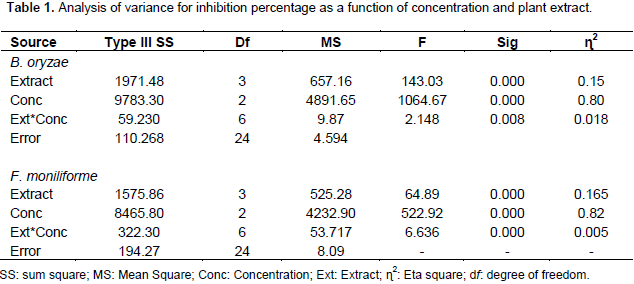
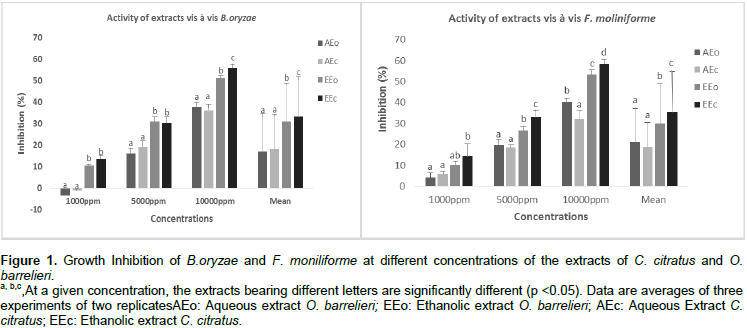
The effect of the concentration was significant with F (2, 24) = 522.92, p < 0.05 for F. moniliforme and F (2, 24) = 1064.67, p < 0.05 for B. oryzae. The growth inhibition of both pathogens was dose dependent. For example AEo 1000 ppm (4.07%) < AEo5000 ppm (19.62%) < EAo10000ppm (40.36%) against F. moniliforme. At 1000 ppm, AEo (-3.33%) and AEc (-1.1%) stimulated the growth of B. oryzae (Figure 1). The extract *concentrations interaction was significant, F (6, 24) = 6.636, p <0.05 and F (6.24) = 2.148, p <0.05, respectively for F. moniliforme and B. oryzae. This shows that the effect of the extract on inhibition is concentration dependent and increases with the concentration increase. Nevertheless, it should be noted that, even though the extract *concentration interaction was statically significant for the inhibition of B. oryzae; the effect size value (Cohen’s f = 0.07) did not meet minimum standard (Cohen’s f ≥ 0.10) to be called a “small” effect size (Cohen, 1988).
Effect of rice seed treatments with NaCl solutions on germination and seed weight
One-way ANOVA was used to compare, the means weight and, the means germination of different seed samples treated with the NaCl solutions. A significant difference was found between the seed samples: F (9, 30) = 143.332, p <0.05 and F (9, 30) = 74.114, p < 0.05 for the percentage of germination and F (9, 30) = 33.64, p <0.05 and F (9, 30) = 30.785, p < 0.05 for the weight, respectively for the red rice of Tonga and Tox 3145-38- 2-3 of Ndop. The nature of the differences between seeds samples were identified and results reported in Table 2. Regardless the rice variety, the weights and the percent germination of the floating (S) seed fractions were significantly low compared to that of their corresponding immersed (C) seeds. Immersed red rice showed a significant (P <0.05) improvement of 7% in germination (T0% C-Sec) when the seeds were sorted with water, and of 19.5% (T20% C- Sec) when sorted in 20% NaCl solution.
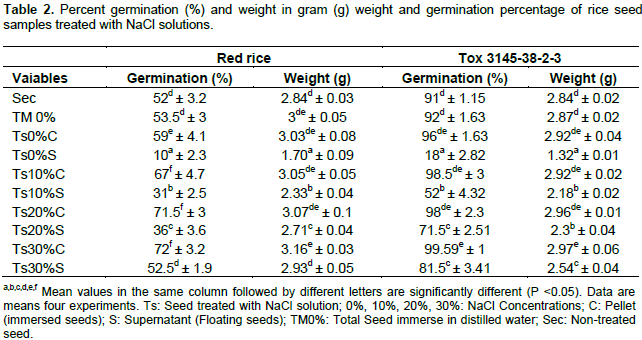
There was no significant difference between the germination of Tox 3145-38-2-3 treated with 20% NaCl and the counterpart immersed in water (T0%C). Irrespective of the rice variety and the type of salt treatment applied, the Spearman rho correlation coefficient between weight and germination was calculated. According to Hopkins (1997), positive moderate correlation was found (Rho (78) = 0.427**, p < 0.01), indicating a significant linear relationship between the two variables: seed lots of high weight, tend to have a higher percentage of germination. The correlation between weight and germination was greater and significant when treatments were examined separately; immersed seeds (Rho (78) = 0.606**, p <0.01) and floated seeds (Rho (78) = 0.543**, P <0.01) or by variety; Red rice (Rho (78) = 0.895**, p <0.01) and Tox 3145-38-2-3 (Rho (78) = 0.903**, p <0.01.
Effect of seed treatment and stress on germination
Three way factor ANOVA was conducted to assess whether the extract, the stress, the treatment had an effect on rice seed germination; and if the germination was affected by the interactions between these independent variables; the results as shown in Table 3. The effect for extract is not significant, F (1, 84) = 1.87, p > 0.05; the estimated marginal mean germination percentage of seed treated with EEc (57%) is not significantly different from the estimated marginal mean germination percentage of seed treated with EEo (56%). The main effect of stress (Stress or stress-free) was significant, F (1, 84) = 142.65, p <0.05; the average marginal germination percentage of seeds subjected to stress by accelerated aging test (52.143%) was lower and significantly different from that of unstressed seeds (60.857%). A significant difference was found among treatments, F (6, 84) = 374.95, p <0.05; regarding the estimated marginal means germination percentage of different treatments, the decreasing order of the effectiveness is as follow T+1% (75.5%) > T+2% (70.6%)> T+4% (68.12%)> T+0% (60%)> Banko Plus (56%) > Sec (43.7%) > T+Sur (21%).

The S-N-K multiple comparison test revealed that the treatments were significantly different from each other, except for T+2% and T+4% which were identical. The variance between groups was mainly explained (86.9%) by the effect of treatment. The extract *stress interaction was significant F (1, 84) = 5.52, p <0.05. This shows that the effect of stress thought accelerated aging test on the germination of rice seeds is dependent on the plant extract used. The germination percentage decreases when moving from stress-free to stress state; this decline was significant and decreased when seeds were soaked in EEo (61.2 -50.7%), than when they are treated with EEc (60.5 to 53.5%) (Figure 2). Meanwhile, the effect size associated with this interaction (Cohen’s f = 0.045) did not satisfy the minimum standard to be called a “small” effect size (Cohen, 1988). The effect of extract *treatment interaction was not significant F (6, 84) = 1.78, p > 0.05; the effect of treatment was not significantly influenced depending on whether the seeds were treated with EEc or EEo. For example, at T+2%, the germination percentage of EEc and EEo were 71.75 and 69.5%, respectively.
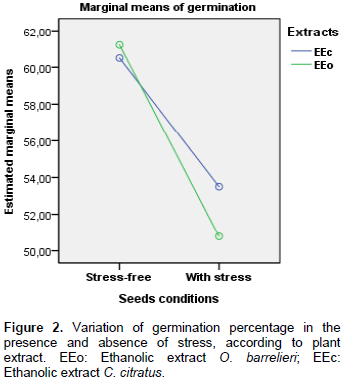
The plots of the percentage of germination as a function of the treatments according to EEc and EEo were alike (Figure 3B). For both plant extracts T+1% treatment showed the highest percentage of germination, EEc (78%) and EEo (73%). The effect of the treatment *stress interaction was significant, F (6, 84) = 15.43, p < 0.05; the effect of the treatment on germination was greatly affected depending on whether the seed samples have been stressed or not. In fact, germination decreases in all seed samples when subjected to vigor test via accelerated aging: T+0% (63.7 to 56.25%), T+1% (78.75 to 72.5%), T+2% (72.25 to 69%), T+4% (71 to 65.25%), Banko Plus (60 to 52%), Sec (56.5 to 31% and et T+Sur (23.75 to 19.25%) there was a significant decrease of the germination (25.5%) for non-treated seeds (Sec) (Figure 3A). The effect of extract *stress *treatment interaction was not significant, F (6, 84) = 0.226, p > 0.05. The effect of the treatment on germination is not significantly affected by the source of extract (EEc or EEo) and whether seed were stressed or not.
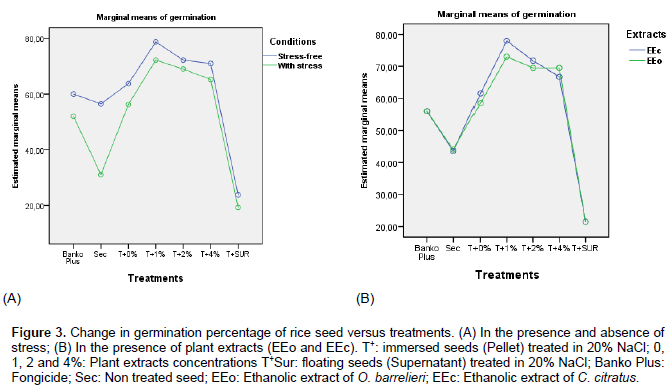
Effects of plant extracts on seed infestation by B. oryzae and F. moniliforme
Two-way factor ANOVA was realized to assess the effects of the extracts, the treatment and the interaction of both factors on the rice seed incidence of B. oryzae and F. moniliforme; the results presented are in Table 4. For B. oryzae incidence (24.71 to 25.5%) or F. moniliforme (14.57 to 16.42%), the effects for extract and extract *treatment interaction were not significant (p > 0.05). The incidence of both fungi did not significantly differ after seed treatments with EEc or EEo. The plots of the variations in the incidence of B. oryzae and F. moniliforme, as a function of treatments with respect of EEc and EEo, respectively are alike (Figure 4A and B). The effect of treatment was significant, F (6, 42) = 22.60, p < 0.05 ɳ2 = 0.750 vis-à-vis B. oryzae incidence and, F (6, 42) = 11.314, p < 0 05 ɳ2 = 0.607 for F. moniliforme seed incidence. The S-N-K test used to detect the nature of differences shows that Banko-Plus reduced significantly the seed incidence of B. oryzae from 46.5a% of non-treated control to 15.5c%; this reduction was statistically same with the treatments T+1%(17.75c %), T+4% (21c %), T+2% (22c %) and T+Sur (22.5c %). The immersion (T+0%) reduced the seed incidence of B. oryzae to 30.5b% as compared to Sec with 46.5a %. F. moniliforme incidence was highest with T+Sur (23.5a %) which was statistically identical to Sec (21.5ab %) and T+0% (21ab %); the incidence of F. moniliforme on seeds treated with Banko Plus (7.5c %), T+4% (7.5c %) and T+2% (15bc %) were lower and similar statistically.
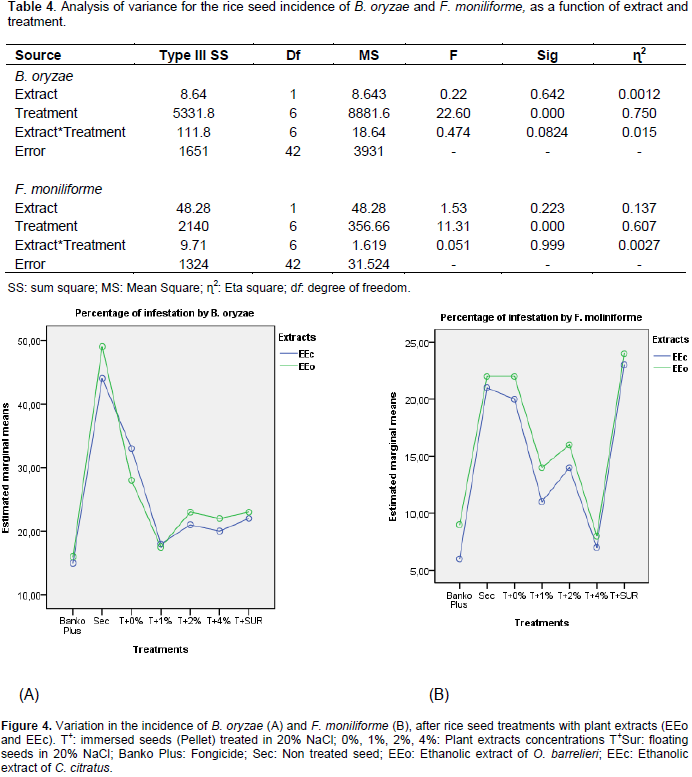
Effect plant extracts on seed emergence
A 7 (Treatments) x 2 (Extracts) between-subjects factorial ANOVA was calculated to compare the emergence for subjects, who had one of the seven treatments and subjects who were treated either with EEc or EEo. It was found that the main effects for extract F (1, 42) = 2.335 p =0.134, ɳ2 = 0.015) and extract *treatment interaction F (6,42) = 2.262, p = 0.56, ɳ2 = 0.090) were not statistically significant (p > 0.05); the marginal mean of emergence of seed treatments with EEc (47.02%) and that of seed treatments with EEo (46.66%) are about the same (Figure 5A). The treatment main effect was significant F (6, 42) = 15.48, p <0.05 ɳ2 = 0.612, the major differences among the treatments and their standard deviations are represented in the Figure 5B. The highest emergence was recorded with treatment T+1% (59.99%) and the lowest with T+Sur (13.33%).
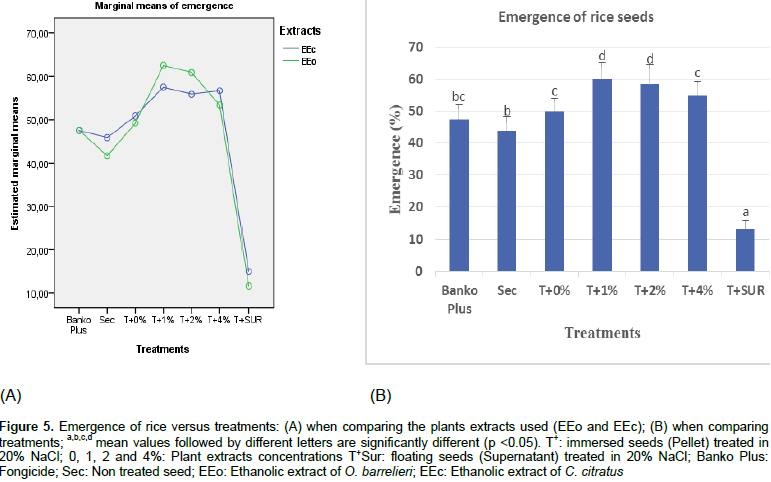
Pearson correlations were computed to examine the associations among the four variables; percentage of germination, seed incidence of B. oryzae, and F. moniliforme, and the emergence. Data in Table 5 showed that four of the six pairs of variables are significantly correlated. The strongest positive correlation, which would be considered to be nearly perfect was found between the germination and the emergence r (54) = 0.931**, p < 0.01 (Hopkins, 1997), The correlation between the seed incidence of F. moniliforme and B. oryzae, was also positive and statistically significant r (54) = 0.448**, p < 0.01. The germination and the emergence were each negatively correlated with the infestation of both pathogens but the correlation with the seed incidence of B. oryzae was not significant (p > 0.01), and the correlation with seed incidence of F. moniliforme was of medium size effects according to Hopkins (1997)
The extracts of O. barrelieri and C. citratus, were tested against two rice seed-borne fungi (B. oryzae and F. moniliforme), and their effects as seed treatments evaluated on the seed fungal incidence, the vigor, the percent germination and emergence of rice seeds sorted in NaCl solutions. In comparison with the findings of Nguefack et al. (2013), in which same methods were used for the evaluation of the antifungal potential, the activities of EEc and AEc against B. oryzae, were near but somewhat less important; this slight difference could be explained by the fact that our extraction period last 12 h against 24 h in theirs; the extraction time may have an influence on the content and/or the chemical composition of the secondary metabolites responsible for the biological (antifungal) effects. Very little work has been done on the phytoprotectory potential of O barrelieri; Its activities vis-à-vis B. oryzae and F. moniliforme are reported here for the first time; Nevertheless, Dakole et al. (2016) showed in their work that AEo and EEo completely inhibited the growth of Fusarium oxysporum f.sp lycopersici at 50000 and 25000 μg / ml and that of Phytophtora infestans at 25000 and 12500 μg/ml, respectively; they suggested the presence of phenols, flavonoids and saponins in these extracts being responsible of this inhibitory effect.
The strong antifungal activity of ethanol extracts thought to be mostly due to its richness in phenolic compounds (Quy et al., 2014) compared to aqueous extracts which contain, among other, considerable quantities of primary metabolites, including polypeptides and carbohydrates (Padmalochana and Rajan, 2014). These primary metabolites may constitute a source of nutrients for fungal growth. The observed stimulatory activity found at low concentration of AEO and AEC on B. oryzae could however, be exploited in the growing of endophytic fungi for better production of secondary metabolites; in fact B. oryzae is capable to produce ophiobolin A and ophiobolin B (Xiao et al, 1991) that could be exploited as herbicide. In order to avoid the negative effect of the saline solution on the germination as found by Khan et al. (2014); seeds were immediately and abundantly rinsed in distilled water after immersion for 1 min in different salt solution. Some authors have found parallel results regarding to the use of aqueous and saline solutions for the sorting of rice seeds. Notably, Pham et al. (2003); found that rice seed cleaning with water reduce unfilled grains by 5.83 to 8.73% in dry season, and discolored grains by 8.32 to 8.65% in rainy season.
In addition, they showed that discolored and spotted rice seeds could be cleaned by treatment in 15% sodium chloride leading to an improvement in the phytosanitary status and germination (4.08 to 14.08%) of seeds; spotted and discolored seeds thus sorted being very often associated with high incidence of pathogens among others, B. Oryzae and F. moniliforme which are liable to deteriorate the seed (Ibrahim and Abo El-Dahab, 2014). The simple cleaning of rice seeds with water, as traditionally often used to subtract failing rice grains, seems limited; the association of NaCl at the right concentration is necessary; this processing means being simple, easy to implement and above all fairly Eco-friendly. Contrary to the findings of Pham et al. (2003), who worked on the sorting of rice seeds by arbitrarily, choosing the 15% brine concentrations, the method used in this work describes a simple and correct scientific approach with end result; the selection of the best NaCl concentration to eliminate the impurities and sort the good qualities grains with maximum germination rate, no matter the state or origin of the grains.
The positive and significant correlation found between the mass of grain and the germination percentage of red and Tox rice varieties corroborate the results obtained by Roy et al. (1996), who showed that the rate of germination and the vigor increase with an increase in the size (weight) of rice seeds; suggesting therefore sorting of heavy grains for a good field establishment. Teng et al. (1992) support this argument by stating that, the best selection criterion for the strength of rice seed is its mass. The high germination of seeds treated with plant extracts (68.12 to 75.5%) compared to floating seeds (21%) and untreated seeds (43.75%), could be partially associated with high incidence in F. moniliforme and B. oryzae on these later seeds. In fact, a study carried out by Imolehin (1983), on seed borne fungi of rice and on their incidence on germination revealed an existence of a strong significant and negative correlation (r = - 0.74) between infestation by these fungi and germination. This seems more true, because we have also found a negative correlation between germination (in vitro and in green house trials) and infestation by each of the two pathogens; however, this correlation was average (r = -0.441) with respect to F. moniliforme and was not significant (-0.127) with regard to B. oryzae.
The drastic drop of the order of 25.5% for the set of dry seeds (non-treated), moderate (7.5%) for seeds soaked in water (T0%) and lesser (5.33%) for set of seeds treated with plant extracts after subjecting the seeds to vigor test via accelerated aging; is in accordance with conclusions drawn by Veselova and Veselovsky (2003) that, accelerated aging is manifested by a reduction in the germination percentage and, seeds that succeed in germinating tend to give raise to brittle seedlings. These results also reveal evidence that, simple soaking of rice seeds in water has contributed in consolidating its vigor under stress conditions, as observed by Ken-Ichi and Jun-Ichi (2013). The plant extracts used in this research could therefore be little more involved in the stimulation of germination than increase in vigor; this being realized through the stimulation of α-amylase activity, the liberation of free soluble sugars and increase in the seeds respiration frequency (Wang et al., 2016) as a result of, the action of their secondary metabolites.
Sorting of rice seeds in 20% NaCl, coupled with their treatment in ethanol extracts of O. barrelieri/C. citratus render seeds more homogenous, maintain their vigor, improve on their health status and germination. This could contribute in; avoiding reseeding, improving the uniformity of growth and maturity stages and finally obtain better yields and good quality seeds for the following campaign.
The authors have not declared any conflict of interests.
REFERENCES
|
Barnwal MK, Kotasthane A, Magculia N, Mukherjee PK, Savary S, Sharma AK, Singh HB, Singh US, Sparks AH, Variar M, Zaidi N (2013). A review on crop losses, epidemiology and disease management of rice brown spot to identify research priorities and knowledge gaps. Eur. J. Plant Pathol. 136:443-457.
Crossref
|
|
|
|
Chandrasekaran B, Annadurai K, Somasundaram E (2010). A Textbook of Agronomy. New Delhi: New Age International (P) Ltd., Publishers 835p.
|
|
|
|
|
Cohen J (1988). Statistical Power Analysis for the Behavioral Sciences. 2nd edition. New York, NY: Routledge Academic, 400p.
|
|
|
|
|
Dakole DC, Nguefack J, Dongmo LJB, Galani YJH, Azah UR, Somda I, Amvam ZPH (2016). Antifungal potential of essential oils, aqueous and ethanol extracts of thirteen plants against Fusarium oxysporum f. sp Lycopersici and Phytophtora infestans (Mont.) de Bary as major tomato pathogens in Cameroon. Int. J. Curr. Sci. 19(2):128-145.
|
|
|
|
|
Delouche JC, Baskin CC (1973). Accelerated ageing techniques for predicting the relative storability of seed lots. Seed Sci. Technol. 1:427-452.
|
|
|
|
|
Dubey NK, Ravindra S, Ashok K, Priyanka S, Bhanu P (2011). Global scenario on the application of natural products in integrated pest management programmers. In: Dubey NK (ed). Natural products in plant pest management. Wallingford: CAB International pp. 1-20.
|
|
|
|
|
Grover RK, Moore JD (1962). Toximetric studies of fungicides against brown rot organism. Sclerotia fructicola and S. laxa. Phytopathol. 52:876-880.
|
|
|
|
|
Hopkins WG (1997). New view of statistics. From
View
|
|
|
|
|
Hu J, Zhu ZY, Song JW, Wang JC, Hu WM (2005). Effects of sand priming on germination and field performance in direct-sown rice (Oryza sativa L.). Seed Sci. Technol. 33(1): 243-248.
Crossref
|
|
|
|
|
Ibrahim EAM, Abo El-Dahab MS (2014). Seed discoloration and their effect on seedlings growth of Egyptian hybrid rice. Res J. Seed Sci. 7(3):63-74.
Crossref
|
|
|
|
|
Imolehin ED (1983). Rice seed borne fungi and their effect on seed germination. Plant Dis. 67:1334-1336.
Crossref
|
|
|
|
|
Ken-Ichi M, Jun-Ichi S (2013). Effects of seed hydropriming on germination and seedling vigor during emergence of rice under different soil moisture conditions. Am. J. Plant Sci. 4:1584-1593.
Crossref
|
|
|
|
|
Khan MHU, Malook I, Atlas A, Jan M, Jan SU, Shah G (2014). The Effect of Sodium Chloride (NaCl) stress on Seed germination and Seedling Growth of Rice (Oryza sativa L.). J. Bio-Mol. Sci. 2(4):100-107.
|
|
|
|
|
Mathur SB, Kongsdal O (2003).Common laboratory seed health testing methods for detecting fungi. 1st ed. International Seed Testing Association, Basersdorf, CH-Switzerland 425p.
|
|
|
|
|
Mew TW, Gonzales PA (2002). Handbook of rice seed-borne fungi. Los Banos, Philippines: International Rice Research Institute and Enfield, N.H USA: Science Publishers, Inc. 84p
|
|
|
|
|
Morgan GA, Leech NL, Gloeckner GW, Barrett KC (2011). IBM SPSS for introductory statistics: use and interpretation, 4th edition. Routledge Taylor & Francis Group, 229p
|
|
|
|
|
Nguefack J, Wulff GE, Dongmo Lekagne JB, Fouelefack FR, Fotio D, Mbo J, Torp J (2013). Effect of plant extracts and an essential oil on the control of brown spot disease, tillering, number of panicles and yield increase in rice. Eur. J. Plant Pathol. 137:871-882.
Crossref
|
|
|
|
|
Oerke EC (2006). Crop losses to pests. J. Agri. Sci. 144: 31-43.
Crossref
|
|
|
|
|
Padmalochana K, Rajan MSD (2014). Antimicrobial activity of aqueous,ethanol and acetone extracts of Sesbania grandiflora leaves and its phytochemical characterization. Int. J. Pharm. Sci. Res. 5(12):957-962.
|
|
|
|
|
Pham VD, Huynh VN, Nguyen DC (2003). Application of seed cleaning in management of seed-borne diseases of rice. Omonrice 11:103-109.
|
|
|
|
|
Quy DD, Artik EA, Phuong LTN, Lien HH, Felycia ES, Suryadi I, Yi HJ (2014). Effect of extraction solvent on total phenol content, total flavonoid content, and antioxidant activity of Limnophila aromatic. J. Food Drug Anal. 22:296-302.
Crossref
|
|
|
|
|
Rao NK, Hanson J, Dulloo ME, Ghosh K, Nowell D and Larinde M (2006). Manual of seed handling in genebanks. Rome (Italy): Bioversity International. Handbooks for Genebanks No. 8.
|
|
|
|
|
Reddy OR, Sathyanarayana N (2001). Seed-borne fungi of rice and quarantine significance In Sreenivasaprasad S., Johnson R. (eds.), Major Fungal diseases of Rice Recent Advances Kluwer Academic Publishers pp. 331-345.
Crossref
|
|
|
|
|
Roy SKS, Hamid A, Miah MG, Hashem A (1996). Seed size variation and its effects on germination and seedling vigour in rice. J. Agron. Crop Sci. 176(2):79-82.
Crossref
|
|
|
|
|
Sharma KK, Singh US, Pankaj S, Ashish K, Lalan S (2015). Seed treatments for sustainable agriculture-A review. J. Appl. Nat. Sci. 7(1):521-539.
|
|
|
|
|
Suraj C, Thawatchai T (2010). Identification of accelerated aging conditions for seed vigor test in rice (Oryza sativa L.). J. RNR Bhutan 6(1):13-23.
|
|
|
|
|
Teng S, Vergara BS, Alejar AA (1992). Relationship of grain length, width, and weight to seedling vigor in rice in rice (Oryzae sativa L). Crop Sci. 17(1): 63-74
|
|
|
|
|
Tripathi P, Dubey NK (2004). Exploitation of natural products as an alternative strategy to control postharvest fungal rotting of fruit and vegetables. Postharv. Biol. Technol. 32:235-245.
Crossref
|
|
|
|
|
Veselova TV, Veselovasky VA (2003). Investigation of atypical germination change during accelerated ageing of pea seeds. Seed Sci. Technol. 31:517-530.
Crossref
|
|
|
|
|
Wang W, Chen Q, Hussain S, Mei J, Dong H, Peng S, Huang J, Cui K, Nie (2016). Pre-sowing seed treatments in direct-seeded early rice: consequences for emergence, seedling growth and associated metabolic events under chilling stress. Sci. Rep. 6:19637.
Crossref
|
|
|
|
|
Wilson C, Tisdell C (2001).Why farmers continue to use pesticides despite environmental, health and sustainability costs. Ecol. Econ. 39:449-462.
Crossref
|
|
|
|
|
Xiao JZ, Tsuda M, Doke N, Nishimura S (1991). Phytotoxins produced by germinating spore of Bipolaris Oryzae. Phytopathology 81:58-64.
Crossref
|
|